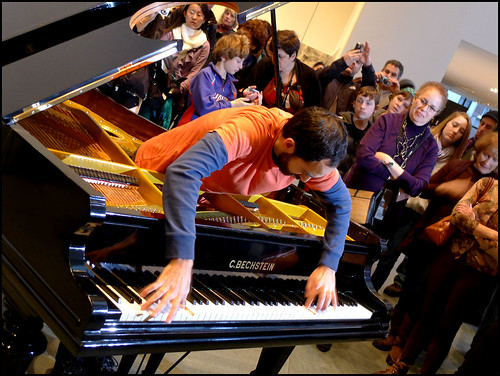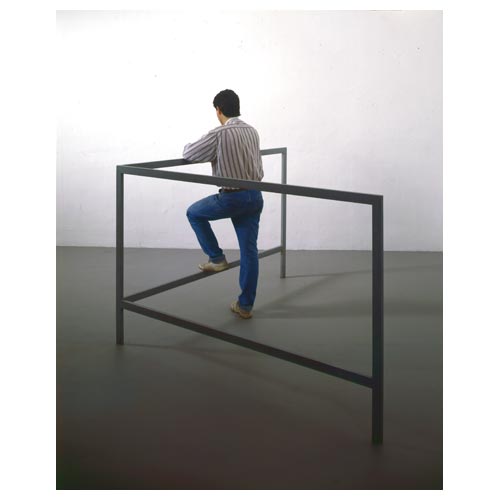So I'm back in Boston, and before classes start up again, I want to mention some of the note-worthy art experiences I had over break.
I took a day trip to New York to go back to MoMA (last time I only had 20 minutes to see the Ab Ex show before I had to catch my bus). SO glad I did! The sheer quantity of paintings in that show is astounding. During our journey through the show, my roommate asked me which was my favorite abstract expressionist, and I must have given her at least five different answers. "Oh man, JOAN MITCHELL, OK, she's my favorite"..."Oh no wait! Sam Francis..." "Mmmmm, DeKooning"...""OH GOD A ROOM OF ROTHKOS!!!! Alright, Rothko might really be my favorite..." And so on for a seemingly endless stretch of rooms. Endless in a good way-- it could have gone on forever, and I still would have been captivated. (The Ab Ex show is up until April 25th, so you have plenty of time to go and be seduced by paint. Just...please don't be a tool and pose obnoxiously in front of the Barnett Newman...we witnessed that happen, and it's the only time I've ever felt really happy about someone being yelled at by the guard)
Also at MoMA that day, we got to see On Line: Drawing Through the Twentieth Century, which incorporated a pleasing array of media. There were many fantastic pieces by many amazing artists (our friend Ms. Schneeman even made an appearance), but the one that stood out most for me was actually the one at the entrance,
Just a Bit More by Ranjani Shettar, which consisted of pigmented beeswax balls held together by tea-dyed thread. I got yelled at for trying to take a picture, but here are some photos someone else was allowed to take, brought to you via the interwebs:


I stared and walked around this piece for about 15 minutes (true, I was waiting for my roommate to return from the bathroom, but it was still pretty damn captivating regardless). I started to see the slight variations in color that created a sort of journey for the beeswax balls, which started to feel like matter or water particles, or networks, or webs. I really really wanted to touch it or duck under and stand amongst them. I'm pretty sure I would've gotten more than yelled at if I'd done so though...(You can see On Line through February 7th)
Oh yeah! On our way upstairs to see On Line, we were distracted by the sound of piano music. It turned out to be
Stop, Repair, Prepare: Variations on "Ode to Joy" for a Prepared Piano, a performance piece by artist team Allora & Calzadilla in which hired professional pianists stand in a hole cut in the center of a grand piano and play the song upside down and in reverse, while simultaneously roaming around through the crowd of onlookers (the piano is on wheels). It was very funny, and it certainly caught the attention of essentially everyone in the museum. I took a picture of the crowds lining the stairwell balconies, looking down on the performance:

and here's a visual of the actual piano-playing:

On Friday, I went with my Mom to the PMA to see the Michelangelo Pistoletto show, which was a pretty excellent retrospective. My favorites were the mirror paintings that implicate the viewer as a victim/ co-conspirator in the action:
 Vietnam
Vietnam
 Man Shooting
Man Shooting Noose
Noose Cage
Cageand
Orchestra of Rags:



For this piece, tea kettles are surrounded by walls of rags and covered with a layer of Plexiglas. When they go off, their trilling disrupts the space, and the condensation from the steam creates shapes on the Plexiglass. We were lucky we got to see it in action--the guard said they only turn the kettles on twice a day!
There's also an auxiliary installation devoted to Pistoletto's work with Cittadellarte, an organization that he founded in Biella, Italy in 1998, which focuses on projects related to art, economics, education, politics, ecology, and communication, fueled by his belief that "art is at the center of a responsible transformation of society". The separate gallery features his
Love Difference Tables, which have traveled to cities all over the world in order to invite discussion and collaboration with various other institutions.


The PMA has been co-sponsoring various events and worshops in conjunction with the exhibition. You can read all about it at the PMA's website. So I guess that kind of makes up for not being allowed to touch
Structure for Talking While Standing Up or Lunch Painting...


(All things Pistoletto end tomorrow! Go see them NOW!)


 It's white paper layered with transparent drafting paper. Exciting, no? More soon!
It's white paper layered with transparent drafting paper. Exciting, no? More soon!


 It's white paper layered with transparent drafting paper. Exciting, no? More soon!
It's white paper layered with transparent drafting paper. Exciting, no? More soon!

 I stared and walked around this piece for about 15 minutes (true, I was waiting for my roommate to return from the bathroom, but it was still pretty damn captivating regardless). I started to see the slight variations in color that created a sort of journey for the beeswax balls, which started to feel like matter or water particles, or networks, or webs. I really really wanted to touch it or duck under and stand amongst them. I'm pretty sure I would've gotten more than yelled at if I'd done so though...(You can see On Line through February 7th)
I stared and walked around this piece for about 15 minutes (true, I was waiting for my roommate to return from the bathroom, but it was still pretty damn captivating regardless). I started to see the slight variations in color that created a sort of journey for the beeswax balls, which started to feel like matter or water particles, or networks, or webs. I really really wanted to touch it or duck under and stand amongst them. I'm pretty sure I would've gotten more than yelled at if I'd done so though...(You can see On Line through February 7th)





 The PMA has been co-sponsoring various events and worshops in conjunction with the exhibition. You can read all about it at the PMA's website. So I guess that kind of makes up for not being allowed to touch Structure for Talking While Standing Up or Lunch Painting...
The PMA has been co-sponsoring various events and worshops in conjunction with the exhibition. You can read all about it at the PMA's website. So I guess that kind of makes up for not being allowed to touch Structure for Talking While Standing Up or Lunch Painting...



 Interior Scroll, 1975
Interior Scroll, 1975
 Rhythm 0, 1974
Rhythm 0, 1974

 My Calling (Cards) #1 & #2, 1986-90
My Calling (Cards) #1 & #2, 1986-90